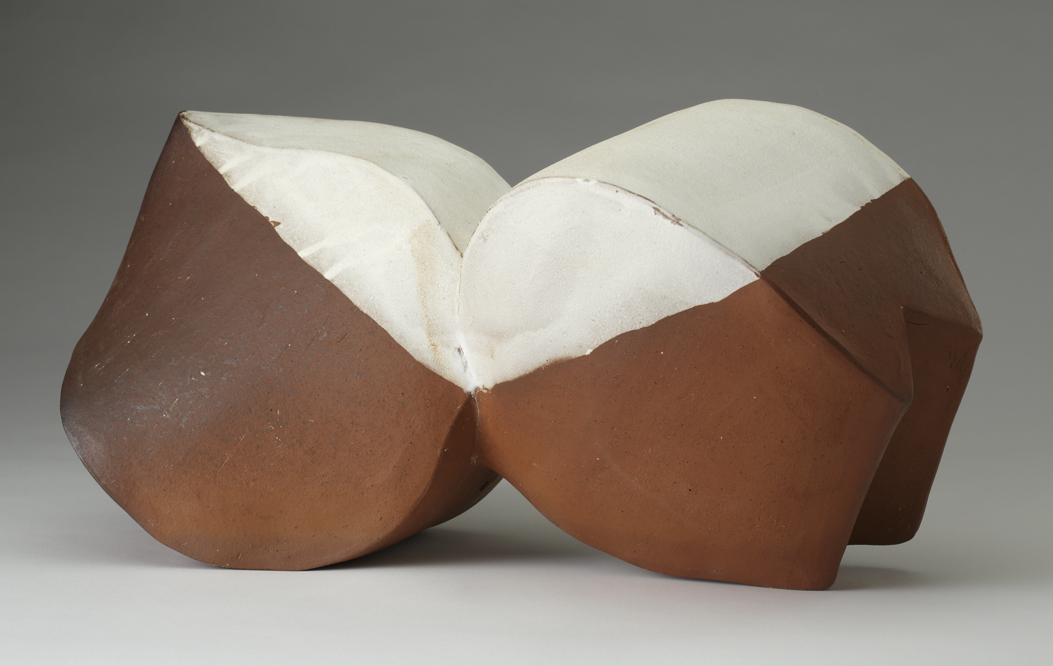Ferrin Contemporary is pleased to present the works of Malcolm Wright and offer them for sale. The collection offers an opportunity to acquire important historical works from an artist who is known by some as a functional potter and by others as a sculptor working in clay, is a consummate craftsman of both. He belongs to a group of contemporary ceramic artists who began as potters throwing vessels on the wheel, and then, seeking to move outside of that tradition, found hand building as a way to broaden their artistic vocabulary.
BRONZE SCULPTURE
The bronze sculpture project started in 2007 when my friend Jay Lindsay, of Carmel NY, wrote that he had bought 800 pounds of bronze ingot. I knew immediately what to do with some of that ingot. As early as 2001 I made some small maquettes of clay sculptures that would translate readily to larger bronze forms. I have kept those forms for future reference, and with Jay’s significant help, ten of these forms have been cast in bronze. Some have been enlarged to a scale of from 15 to 26 inches. Some have been cast in the original scale of five to eight inches.
So why am I interested in bronze? When I began working in clay sculpture, the first pieces were glazed and rather shiny. I was then drawn to working with the dark, porous- appearing, rather dry, wood-fired brick clay. The bronze surface is somewhere in between, cool and hard, but not reflective.
Bronze carries a feeling of permanence. When I arrive at a form that, to my eye, appears mature, I have a desire to see it realized in bronze. Bronze of the material works for my forms.
—Malcolm Wright
CONSTRUCTED FORMS IN STONEWARE
The majority of my work is glazed, functional stoneware. It is inspired by eight years of study under Japanese teachers from 1963 to 1970, including two years in Karatsu, Japan. My work is also informed by Korean and Chinese ceramics. Although born in Minnesota, somewhere west of Lake Woebegone, I am of English and Scottish descent, so these cultures also have a strong influence. The forms are accessible, the glazes are mostly ash based and glossy, the wood fire leaves only modest marks on the pot, except for those pieces positioned at the front of the kiln chamber. This work is fired at 2300 to 2500°F.
—Malcolm Wright
CUBES & HOUSES IN BRICK CLAY
Brick clay works are fired at a moderate temperature of 2000 to 2100°F in what I call a soft fire method, using no glazes. The clay is just barely fused and the ash is just slightly melted. I hope to achieve brick reds, ochres, occasionally dark shades of blue and green with black around the edges. The outside surfaces show darker blacks with strong fire marks. These works are placed into the kiln without decoration and the fire does all the work.
—Malcolm Wright
POD FORMS IN WOOD FIRED BRICK CLAY
SCULPTURAL FORMS IN WOOD FIRED BRICK CLAY
SEA & STAR CREATURES IN WOOD FIRED BRICK CLAY
WORKS IN MUSEUMS & COLLECTIONS
ABOUT
American, b. 1939, Minnesota
worked in Marlboro, VT; lives in Shelburne, VT
Malcolm Wright, who is known by some as a functional potter and by others as a sculptor working in clay, is a consummate craftsman of both. He belongs to a group of contemporary ceramic artists who began as potters throwing vessels on the wheel, and then, seeking to move outside of that tradition, found hand building as a way to broaden their artistic vocabulary. From the 1960s until his retirement in 2015, Wright produced a prodigious body of functional stoneware that was honed from an immersion in the Japanese tradition of Karatsu pottery. Since about 2000, he constructed handbuilt, tabletop-sized sculptures, setting aside the notion that clay objects must serve a functional purpose. Both bodies of work have been wood-fired, mostly in his “split bamboo” Korean-style kiln, set on property in rural Marlboro, Vermont, where Wright and his family lived for over 45 years.
Malcolm Wright was born in Minnesota. He earned a BA from Marlboro College, an MFA from George Washington University, and was an apprentice to a 12th-generation Japa- nese potter Tarouemon Nakazato in Karatsu, Japan, working directly under Takashi Nakazato.
MORE ON MALCOLM WRIGHT
In my college years, I was interested in the roots of modernism, from the development of cubism, constructivism, and futurism to Scandinavian design, and the time/ space elements in architecture. These interests were interrupted for 30 years by my deep involvement with Japan, functional pottery for food and owers, and in the ascetic, restrained taste of tea ceremony pottery.
Over the last 35 years, my early interest has reawakened. Walking around the fields among Chuck Ginnivers’s monumental sculptures, here in Vermont, inspired me to revisit these interests. Slowly, I became aware of the power of minimalism as expressed in Tony Smith’s work. More recently, the work of Jorge Oteiza and the foam sculptures of John Chamberlin have been a source of inspiration.
The nature of clay and my years working with tabletop scale directs me to a small size that is comfortable, yet retains power. I am interested in dry surfaces, without ash build up, and negative space. I think the sense of Japanese restraint and Western minimalism combine in these pieces, the forms, and ideas I studied more that 50 years ago.
— Malcolm Wright
View Malcolm’s Catalog:
ADDITIONAL PRESS & MEDIA
“Profiles of Late Style:
Malcolm Wright”
by Leah Hood,
Nov 18, 2016
Published date 2018





















































You must be logged in to post a comment.